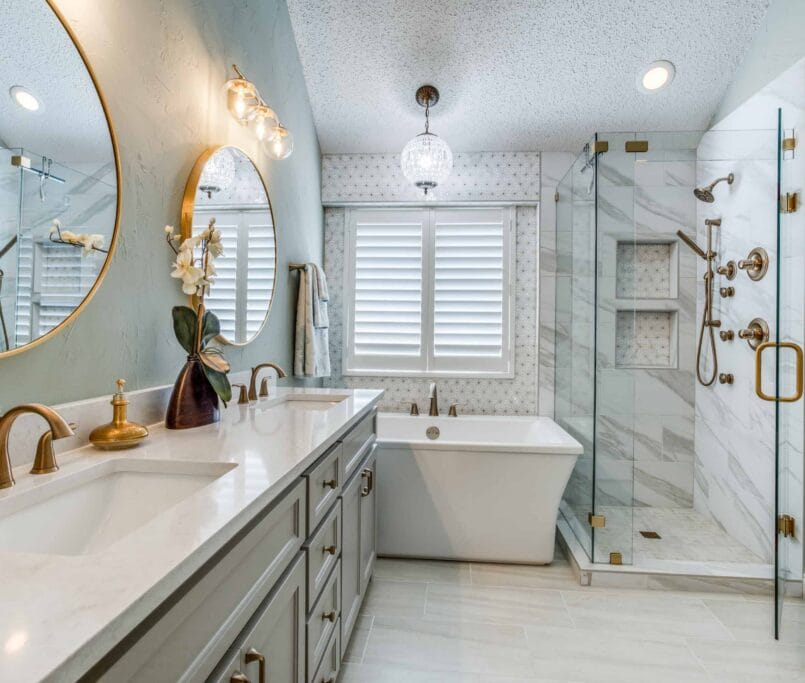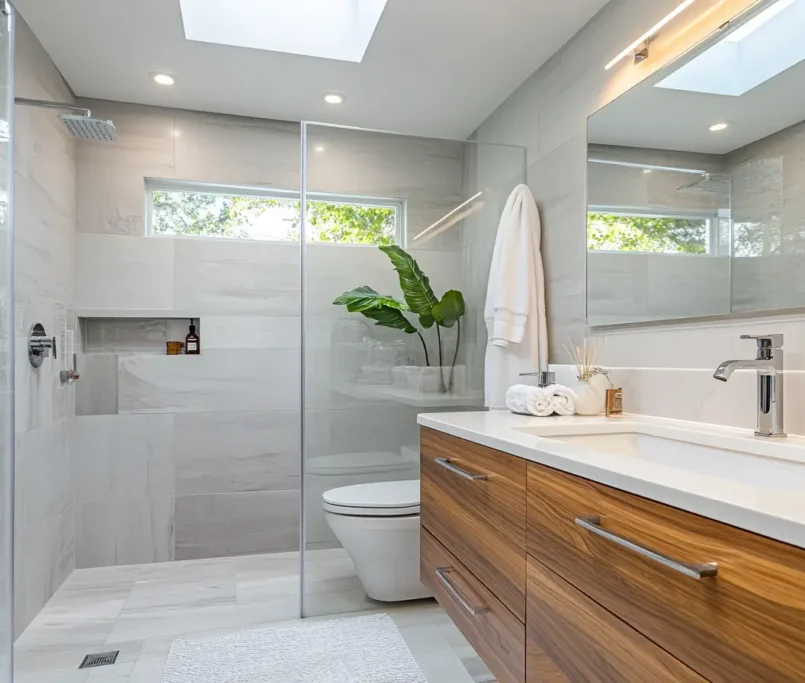Why You Should Consider an Eco-Friendly and Sustainable Bathroom Remodels
As the world continues to focus on sustainability, homeowners are increasingly looking for ways to make their homes more eco-friendly. One area where this trend is particularly impactful is bathroom remodels. Traditionally, bathrooms have been a space for utility, with little attention given to the materials, fixtures, or systems that contribute to environmental sustainability. However, as more people become aware of the environmental impact of home renovations, eco-friendly bathroom remodels have gained popularity.
An eco-friendly bathroom remodel not only helps reduce your carbon footprint but can also save you money in the long run. With the rising costs of utilities, investing in water-saving fixtures, energy-efficient lighting, and sustainable materials can lead to significant savings on your water and energy bills. Furthermore, eco-conscious bathroom features like natural finishes and non-toxic paints improve air quality and reduce harmful chemicals in your home.
This blog will guide you through the essentials of an eco-friendly bathroom remodel, offering practical advice on selecting sustainable materials, water-saving fixtures, energy-efficient systems, and more. By focusing on sustainability, you can create a beautiful, functional bathroom that’s kind to the planet—and your wallet.
A Guide to Eco-Friendly Bathroom Remodels
Eco-friendly bathroom remodels are all about making sustainable choices that benefit both the environment and your living space. In 2025, homeowners are opting for sustainable materials like bamboo and recycled glass, water-saving fixtures, and energy-efficient systems that reduce their carbon footprint. Whether you are replacing your showerhead or updating your flooring, choosing eco-friendly options will not only help conserve resources but also create a healthier bathroom environment. In this blog, we’ll explore sustainable materials, water-saving features, and energy-efficient solutions for your next bathroom remodel.
1. Choosing Sustainable Materials for Your Bathroom
When it comes to bathroom remodels, choosing the right materials is crucial. Sustainable materials reduce environmental impact, are long-lasting, and often offer a unique, modern aesthetic. Recycled, reclaimed, and natural materials are ideal choices for an eco-friendly bathroom remodel.
Sustainable Materials to Consider:
- Recycled Glass: Recycled glass tiles and countertops are a beautiful and environmentally friendly option for bathrooms. They come in a variety of colors and designs and are made from repurposed glass, which reduces waste and cuts down on the need for new raw materials.
- Bamboo: Bamboo is a renewable resource that grows quickly and is incredibly durable. It’s perfect for flooring, cabinetry, and even as an alternative to wood for shelving or storage.
- Cork: Cork is another sustainable material that works well in bathrooms. It’s naturally water-resistant, easy to maintain, and provides a soft, natural look to floors or wall coverings.
- Reclaimed Wood: For a rustic, earthy feel, reclaimed wood is an excellent choice. Using wood that has already been harvested and used helps reduce deforestation and repurposes old materials that would otherwise go to waste.
Benefits of Sustainable Materials
By choosing sustainable materials, you not only contribute to environmental preservation but also ensure your bathroom is both stylish and durable. Sustainable materials tend to be higher in quality, which means fewer replacements and repairs over time.
2. Water-Saving Fixtures and Appliances
Bathrooms are one of the highest water-consuming areas of the home, making water-saving fixtures a key element in an eco-friendly bathroom remodel. Modern water-saving products are designed to conserve water without sacrificing performance.
Water-Efficient Fixtures:
- Low-Flow Toilets: Low-flow toilets use less water per flush while maintaining flushing power. They can save thousands of gallons of water each year and significantly lower your water bill.
- Water-Saving Showerheads: Water-efficient showerheads use advanced technology to reduce water flow while maintaining a satisfying shower experience. Look for showerheads labeled with the WaterSense label for guaranteed water efficiency.
- Faucets with Aerators: Installing faucets with built-in aerators reduces water flow by mixing air with water, which decreases water usage while still providing enough pressure for washing hands or brushing teeth.
Benefits of Water-Saving Fixtures
Installing water-saving fixtures reduces your home’s water consumption, lowers utility bills, and conserves valuable water resources. These fixtures are particularly important in regions experiencing water shortages or areas that emphasize sustainability.
3. Energy-Efficient Lighting and Ventilation
Lighting and ventilation are essential parts of bathroom functionality, but they also have significant environmental impacts. By selecting energy-efficient lighting and ventilation systems, you can reduce energy usage while maintaining comfort in your bathroom.
Energy-Efficient Lighting:
- LED Bulbs: LED lighting is the most energy-efficient option available. LED bulbs use less electricity, last longer, and generate less heat compared to traditional incandescent bulbs. They can be used in overhead lights, vanity lights, or even as accent lighting.
- Motion-Sensor Lights: Installing motion sensors in your bathroom ensures that lights are only on when needed, which helps conserve electricity and extends the lifespan of your bulbs.
Energy-Efficient Ventilation:
- Energy Star-Rated Exhaust Fans: Energy-efficient exhaust fans help improve ventilation in your bathroom by reducing humidity and preventing mold growth. Choosing a fan with an Energy Star rating ensures that it uses minimal energy while performing effectively.
- Natural Ventilation: When possible, take advantage of natural ventilation by installing windows that open or adding skylights. This reduces the need for artificial ventilation systems and promotes fresh airflow.
Benefits of Energy-Efficient Systems
Energy-efficient lighting and ventilation systems reduce your carbon footprint, save you money on electricity bills, and create a more comfortable, eco-friendly bathroom environment. These solutions are key to achieving a truly sustainable remodel.
4. Natural and Non-Toxic Finishes
Many traditional paints, stains, and finishes contain harmful chemicals that can affect indoor air quality and contribute to environmental pollution. Choosing natural and non-toxic finishes ensures that your bathroom remains safe and healthy for your family and the environment.
Non-Toxic Finishes to Consider:
- Low-VOC Paints: Volatile Organic Compounds (VOCs) are harmful chemicals commonly found in paints. Opt for low-VOC or no-VOC paints to minimize air pollution and create a healthier indoor environment.
- Natural Wood Finishes: Use natural oils, beeswax, or plant-based varnishes to finish wood surfaces. These finishes are safe, non-toxic, and provide a rich, natural look.
- Eco-Friendly Sealants: For bathroom surfaces like countertops and floors, choose eco-friendly sealants made from natural ingredients. These are safe for the environment and provide effective protection against moisture and stains.
Benefits of Non-Toxic Finishes
Non-toxic finishes not only improve air quality but also contribute to the overall sustainability of your bathroom remodel. By using safer products, you reduce the risk of exposure to harmful chemicals while enhancing the natural beauty of your bathroom.
5. Recycling and Upcycling in Bathroom Remodels
Recycling and upcycling are great ways to incorporate eco-friendly practices into your bathroom remodel. Instead of discarding old fixtures, consider reusing or repurposing materials to create a unique and sustainable design.
Ideas for Recycling and Upcycling:
- Repurpose Old Cabinets: If your cabinets are in good condition but outdated, consider repainting or refinishing them instead of replacing them entirely. Adding new hardware can completely change the look without the need for a full replacement.
- Repurpose Old Fixtures: Old mirrors, lights, and even bathtubs can be upcycled with a little creativity. For example, you can turn an old mirror frame into a stylish new piece with a coat of paint or add a new mirror insert.
- Recycled Materials: Incorporate recycled materials like reclaimed wood, metal, or glass for a unique, sustainable design. These materials give your bathroom a one-of-a-kind look while reducing waste.
Benefits of Recycling and Upcycling
Recycling and upcycling are great for reducing waste and saving money. Not only do these methods support sustainability, but they also add character and charm to your bathroom remodel, giving it a unique, eco-conscious feel.
6. Planning for Long-Term Sustainability
In addition to choosing eco-friendly materials and features, consider the long-term sustainability of your bathroom remodel. The choices you make today can help minimize the need for future renovations and reduce your environmental impact over time.
Long-Term Sustainability Tips:
- Durable Fixtures: Choose high-quality fixtures and materials that will last for years. Durable products reduce the need for replacements, preventing unnecessary waste.
- Timeless Design: Opt for a classic design that won’t go out of style. Timeless designs not only age well but also prevent the need for frequent updates or remodels.
Benefits of Long-Term Sustainability
By planning for long-term sustainability, you reduce future waste, save money on repairs or replacements, and contribute to the overall longevity of your home’s eco-friendly features.

Why an Eco-Friendly Bathroom Remodel is Worth the Investment
Eco-friendly bathroom remodels are a great way to combine sustainability, style, and functionality. Whether you’re opting for water-saving fixtures, energy-efficient systems, or sustainable materials, every eco-friendly choice you make benefits both the environment and your wallet. With rising utility costs and growing environmental concerns, making sustainable choices in your bathroom remodel is not just good for the planet but a smart financial decision in the long run.
Ready to make your bathroom more eco-friendly? Contact Grand Building Construction for expert sustainable bathroom remodeling advice and services!
FAQs
Q1: What are the best sustainable materials for a bathroom remodel?
Recycled glass, bamboo, reclaimed wood, and cork are excellent sustainable materials for bathroom remodels. These materials are durable, stylish, and environmentally friendly.
Q2: How can I make my bathroom more water-efficient?
Install low-flow toilets, water-saving showerheads, and faucets with aerators. These fixtures reduce water consumption without compromising performance.
Q3: Are eco-friendly bathroom remodels expensive?
While some sustainable materials may cost more upfront, they save money in the long run through lower utility bills and reduced maintenance. Many eco-friendly options are affordable and can fit any budget.



